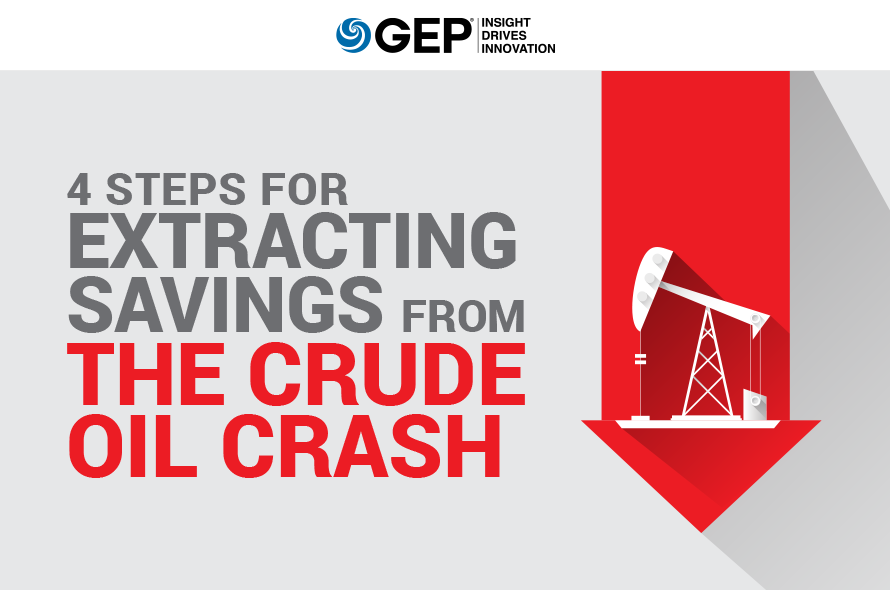Oil prices hit record multi-year lows recently. With Saudi Arabia and Russia engaged in a price war, and global crude oil demand slipping due to the pandemic — oil prices are likely to remain low for a while.
This presents an opportunity for procurement to drive savings and mitigate some financial impact of the pandemic-induced slowdown.
Wondering where to start? Our latest bulletin, “4 Steps to Extract Savings from the Crude Oil Crash,” provides a rapid action plan for procurement teams to identify, assess and quickly realize savings opportunities across spend categories.
What’s Inside:
- How to identify categories with greater savings opportunities
- How to develop category-specific strategies for purchasing
- How to use the right negotiation levers
Read it today and learn how you can quickly shift gears to capture savings for your enterprise.
A “perfect storm” of global events has recently caused crude oil prices to plummet. The global coronavirus pandemic has created a dramatic decline in demand, resulting in a substantial oversupply with no production cuts on the horizon. Overall demand is expected to shrink by 12–20 million barrels a day.1 That would be pretty momentous by itself. But Saudi Arabia flooded the market with cheap oil in order to gain market share, and in response, Russia announced production increases.
Even though OPEC and its allies have now announced large production cuts, oil prices are expected to remain near their lows for some time. While the production cuts likely prevented further price drops, they won’t go far enough to cause prices to increase.2
So what should procurement be doing at this unprecedented time? Strategic procurement organizations should constantly be looking for savings opportunities to help their companies’ competitiveness and profitability — and plummeting oil prices have provided an immediate opportunity.
Here are the four key steps to follow to take full advantage of this exceptional situation:
Step 1: Assess
First, every procurement organization should plan to assess the impact of this sudden reduction in crude oil pricing on its portfolio. The assessment needs to be high-level to quickly identify the opportunity and the level of investment required to capture the savings. However, the assessment should factor in key criteria to ensure the savings estimates are achievable. The last thing a procurement organization wants to do is ask for investments at this critical time, and then not be able to deliver a strong ROI.
The assessment should aim to evaluate the savings potential based on various categories of goods and services purchased by the organization. Obviously, logistics, chemicals, packaging and MRO (industrial supplies, PPE, lubricants, etc.) are likely to be most affected by a drop in crude oil prices. However, a broad-brush approach for categories like chemicals is not an appropriate assessment. Upstream chemicals (basic/commodity chemicals, petrochemicals) are impacted heavily while downstream chemicals (specialty chemicals, fine chemicals, agrochemicals) see a reduced impact.
Additionally, the assessment should factor in variable-priced contracts (based on a crude price index) and fixed-price contracts. Savings from a crude oil price reduction will be achieved automatically for the variable-priced contracts — assuming they are negotiated, and the price adjustment mechanism set up appropriately. However, fixed-price contracts will have to be evaluated for opportunities to renegotiate pricing based on termination clauses and supplier relationships.
Step 2: Develop a Plan to Capture the Savings and Prepare the Procurement Team
Simply asking category managers and buyers to negotiate with their suppliers is not going to yield the expected results from the assessment described above. Procurement leadership needs to develop a defined strategy and inform their teams through a playbook or guide on how to realize the expected savings.
Keep in mind that strategies can be different for different spend areas. For example, with fixed-price contracts, one option could be to push back the contracted volume for future purchases and procure the immediately-needed volume from the spot market to take advantage of lower market pricing. Each team member should be provided a target based on their portfolio of spend. Training should also be conducted for procurement personnel so that they are fully fluent in the oil value capture strategy and approach.
Procurement should align up front with finance on any savings methodologies. Teams should also consider alignment with business units whose financial results could be affected. The key is to be able to measure procurement’s impact on the organization and leverage it to build future relationships.
Additionally, ensure all contracts are stored in a centralized repository with access available to pertinent stakeholders. Quick access to contracts and data is critical for procurement leadership to be able to make timely decisions and lock in savings without dragging out negotiations.
The final preparation step is developing a strong PMO/reporting process that helps provide procurement leadership with the visibility they need to ensure savings are on track to being achieved. Any issues or roadblocks should be easily identified through the PMO process, signaling the leadership to step in and provide support. The PMO process should be streamlined and straightforward — enabling teams to focus their time on achieving results, instead of dedicating large chunks of time to internal reporting.
Step 3: Negotiate
Suppliers should be segmented, since the savings levers for each segment vary across the board. Segmentation can be by level of spend, category/commodity type, estimated savings, level of relationship, etc. Hard negotiations and the old-school approach of “beating up” suppliers could deliver short-term savings. But most procurement organizations now look to capture long-term savings and need to be more strategic in how they approach their suppliers. Keep in mind, oil prices will inevitably go up, and the ability to build relationships with suppliers and negotiate with a longer-term outlook will likely help minimize the impact when oil prices increase.
The PMO and reporting process is important during the negotiation phase, because it will enable the PMO and leadership team to assess how well their strategies are working. Also, negotiation feedback from category managers and suppliers should be recorded to analyze whether any adjustments to the value capture strategy are needed. If particular aspects of the strategy are working well to maximize savings, those should be highlighted for the rest of the team. The ability to quickly adjust and optimize the strategy will be pivotal in delivering, or ideally over-delivering, the savings.
Step 4: Document and Capture
By now, hopefully, the procurement team has achieved its targeted savings and is looking like heroes to the rest of the organization. However, the job is not done. It’s important to capture the lessons learned, document the process, and save all the information that was gathered. An upturn will be coming, and the same levers that were used against suppliers will be used again by the suppliers against your organization. It’s also important to ensure that all renegotiated pricing is updated in the appropriate systems and documentation (contracts, SOWs, POs, etc.).
To sum up, there is likely significant opportunity for most organizations to re-evaluate their pricing and discounts with suppliers based on significant crude oil price drops. But to take full advantage of this circumstance, it’s crucial for procurement organizations to properly assess, plan and execute a well-thought-out strategy. It’s imperative to align internally and develop an overall strategy that each category manager can deploy. Don’t forget that, in the end, what goes up must come down — and vice versa.
RAPID RESPONSE SOLUTIONS FROM GEP
As the coronavirus crisis intensifies, managing your supply chain is going to get even more challenging. It may be worth finding a partner with deep experience in procurement and supply chain management to reinforce your capabilities and help you stay on course.
If you would like to have a conversation about how we can help, please reach out to our supply chain leadership.

Samir Patel
Vice President, Consulting GEP
Samir leads GEP’s chemicals vertical. He has over 17 years of industry and consulting experience in implementing cost reduction programs at Fortune 500 clients. He has delivered significant value to clients through strategic sourcing, category strategies and best practices, M&A synergy savings, and procurement transformation, in addition to leading procurement execution and strategy for integration and divestitures.

